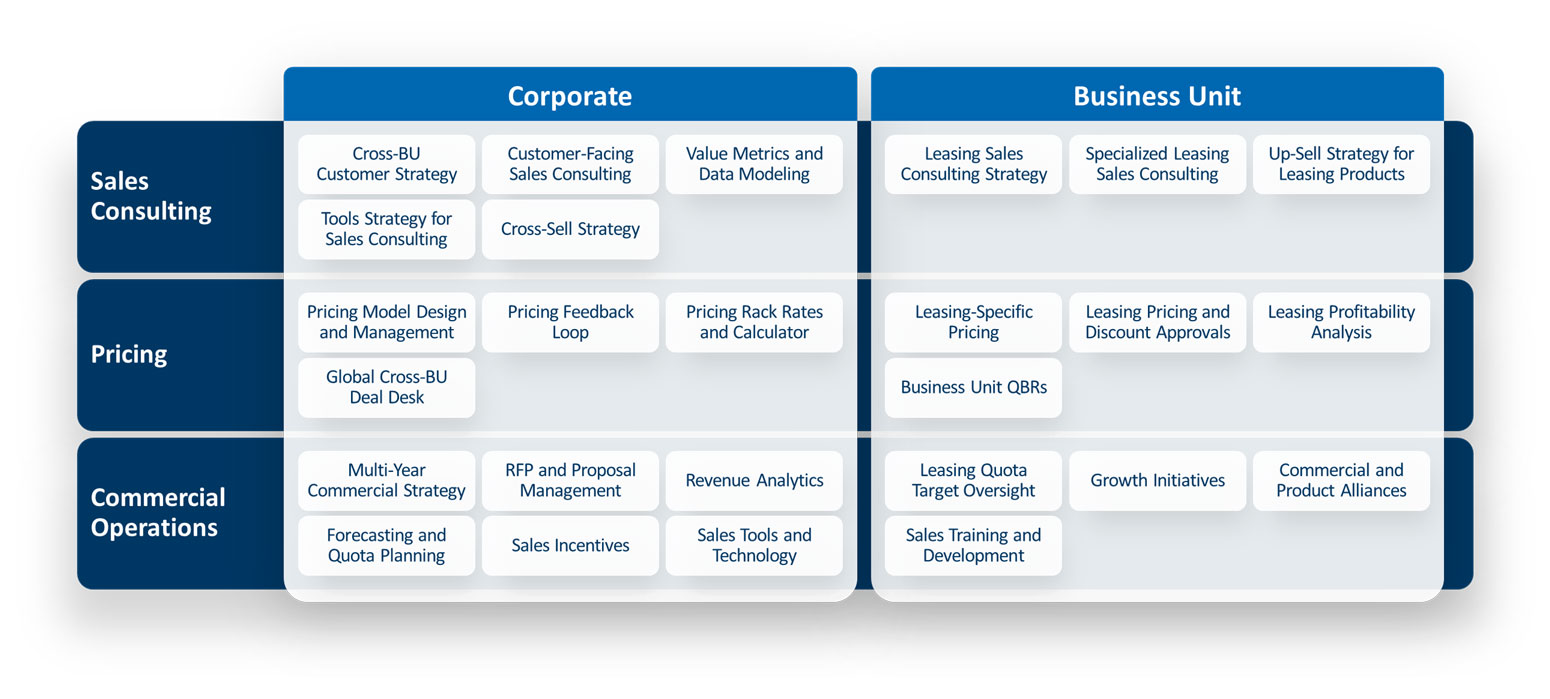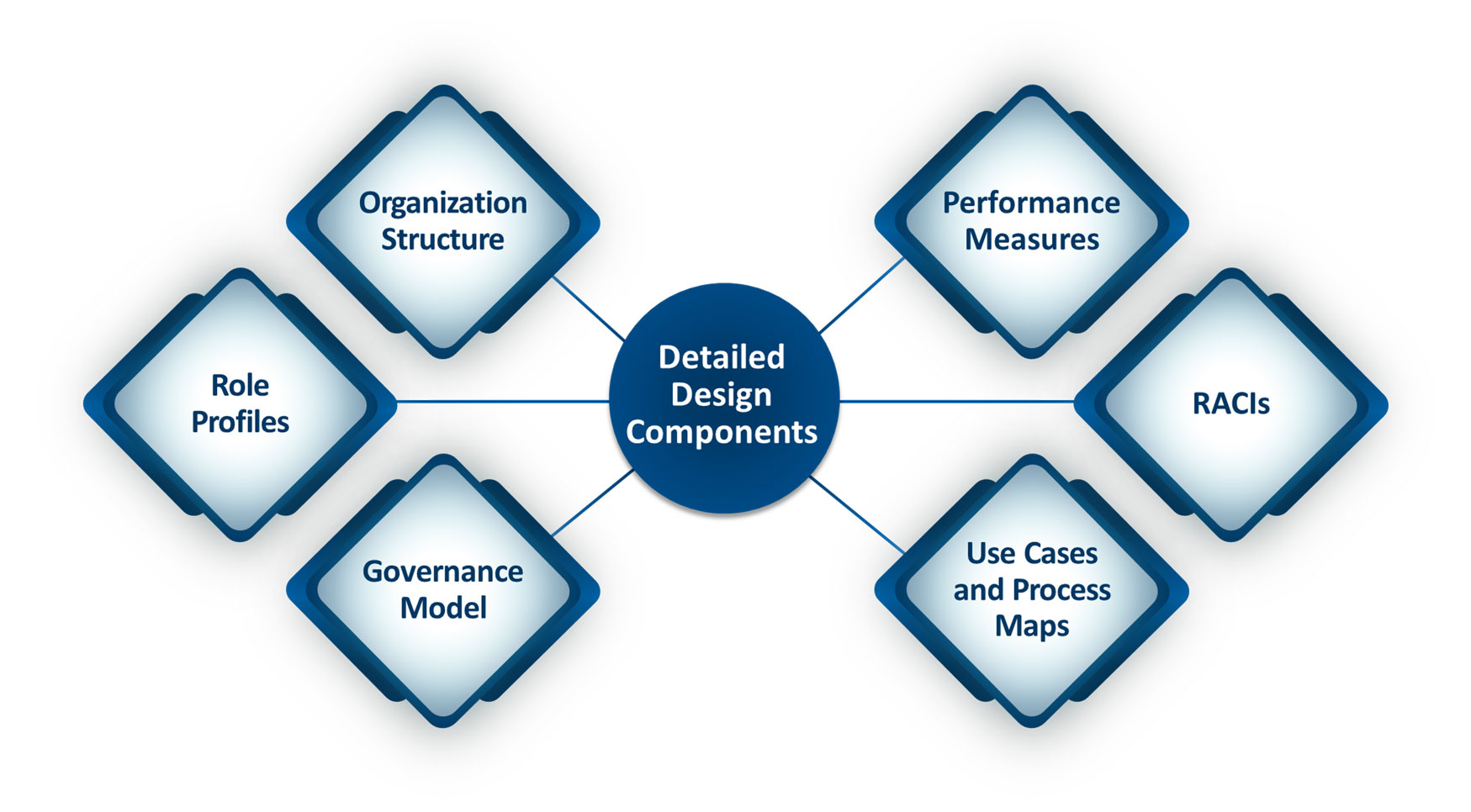Turning Vision and Strategy Into Action: The Role of Operating Model Design
Designing Operating Models That Translate Strategy Into Measurable Performance
-
October 02, 2025
-
A well-designed operating model is the difference between strategy on paper and strategy in action. Even the strongest offerings and most talented teams struggle to deliver results without the right structure, processes and governance to enable them.
Successful operating models put capabilities in the right place functionally, geographically and organizationally, and align structure, processes and governance to help them perform. Built too lean, the business lacks the right enablers to maximize revenue potential. Built too heavy, margins are suppressed.
When it comes to operating model design, balance is everything. Too often, the process is reduced to “names in boxes” — titles, leadership levels and spans of control. In reality, it’s a broader exercise that includes addressing:
- What capabilities are needed?
- Where should capabilities sit organizationally?
- What are the roles and which teams execute them?
- How are processes designed and aligned?
- What policies guide processes within internal and external controls?
- What tools and technology enable those processes?
- What metrics will measure success?
Any operating model design process starts with identifying the guiding principles that inform decisions and define required capabilities.
For the same $1 billion North American leasing client featured in our previous article, our objective was to establish a new business unit. We applied a structured approach, defined guiding principles and conducted capability mapping to determine which activities should be managed at the business unit level versus the corporate level. From there, we executed six detailed design steps to stand up the new unit and reconfigure the broader operating model.
This work, combined with program management, governance, change management and communications support from FTI Consulting, enabled the unit to launch quickly and exceed its performance objectives.
That journey, however, started with two foundational focus areas.
The Foundation: Guiding Principles and Capability Mapping
First, before any conversation about capabilities or other operating model components, the leadership team needs to align on the guiding principles that govern the design process. Aim to compile a list of five core principles that can be used consistently for discussion and decision-making.
For example, if one of the organization’s top priorities is to improve customer experience, every operating model decision should take into account how customers will be affected. Similarly, if the goal is to streamline operations and simplify the business, designing a structure with more layers and added complexity should not be considered.
Leadership should document these guiding principles and ensure all stakeholders are aligned on their importance. This early validation sets the tone and provides the foundation for capability mapping.
Second, the new operating model depends on identifying the core capabilities required to achieve the organization’s objectives. Outline the capabilities needed in the future operating model at a functional level by asking: What will our organization need in the target state to deliver on our vision and strategy?
From a finance perspective, this may include financial analysis and reporting that tracks performance against key metrics. The strategy may also require top-tier talent from the market, necessitating talent acquisition and retention capability.
Commercially, capabilities may include sales strategy, deal desk, pricing and sales incentives. The organization must also consider where these capabilities are best accomplished. Multiple delivery models exist, each with pros and cons. A capability map shows where responsibility for each capability lies.
Use this exercise as an opportunity to design the operating model with a blank-sheet approach. For each function, define corporate versus business unit or center of excellence responsibilities, then list the target capabilities under each.
Below is an illustrative example of commercial capability mapping at the $1 billion leasing company introduced previously. Business unit level capabilities are specific to leasing products, while capabilities needed across products are delivered through shared services or corporate functions.
Centralizing capabilities within a center of excellence, like for data and analytics, with global oversight is one model. Decentralizing capabilities is another. In the case of multiple business units, some organizations may benefit from having certain capabilities, like talent acquisition, embedded within each business rather than consolidated centrally. Guiding principles are critical at this stage for decision-making.
Detailed Design Components
After design principles and the capability framework are defined, the next step is to build the complete operating model. There are six components of the detailed design:
- Organization Structure: People enable most capabilities in the operating model. This requires defining new roles, redefining existing roles and assessing activity volumes to balance work-load. Start with an inventory of the current team members and identify talent gaps. Next, decide how the team will be structured — names in boxes, spans of control and reporting relationships. With a new structure in place, complete a quick impact assessment to determine where additions, reductions or changes in headcount are required, including promotes or expanded mandates.
- Role Profiles: The next step is to create role profiles. These are typically one-page overviews of key responsibilities, decision authorities and outcomes associated with each role. Additionally, identify the key cross-functional partners required for success. This exercise provides useful input for developing job descriptions and recruiting.
- Governance Model: Operating model changes can reduce clarity around decision-making authority and escalation paths. Any changes to governance bodies or committees need to be properly documented. Use the new structure and role profiles to create governance charters that capture escalation paths, committee mandates, members, meeting cadences and out-puts, and secure buy-in across all parties.
- Use Cases and Process Maps: Mapping the highest-impact use cases and documenting clear process flows reduces ambiguity. New operating models require changes in management and training. Identifying key processes that will change the most from current to future state and outlining how they will now work at an activity level — including process steps, handoffs, tools interactions and responsibilities — simplifies change. Selecting top use cases is a great step forward. This step should also capture the policies that guide internal and external processes and compliance requirements.
- RACIs: Clarifying who is responsible, accountable, consulted and informed (“RACI”) across an operating model’s key activities or decision-making processes keeps teams aligned. As the new model is rolled out, individuals may revert to old ways of working or overstep boundaries. RACIs reinforce the intended process and accountability.
- Performance Measures: Outcomes matter. As the full operating model takes shape, clear metrics and KPIs must be defined to measure success. Consider KPIs across three areas — financial, operational and customer experience — with clear accountability on both the business unit and its corporate and shared service counterparts. Define how metrics will be tracked and reported in a way that is transparent to the executive team and enables accountability.
Each of these six components plays a critical role in testing the model, addressing gaps and preparing the team for change. The output is a comprehensive playbook that clarifies roles, responsibilities, structure, process and governance for execution.
Operating model design can feel complex. However, when done thoughtfully, it is one of the most powerful levers that leaders have to unlock growth, improve margins and strengthen both customer and employee outcomes. The right model becomes a playbook for execution, ensuring strategy delivers measurable impact.
Published
October 02, 2025
 Key Contacts
Key Contacts
Senior Managing Director, Leader of Merger Integration & Carve-Outs
Senior Managing Director
Managing Director
Senior Director




